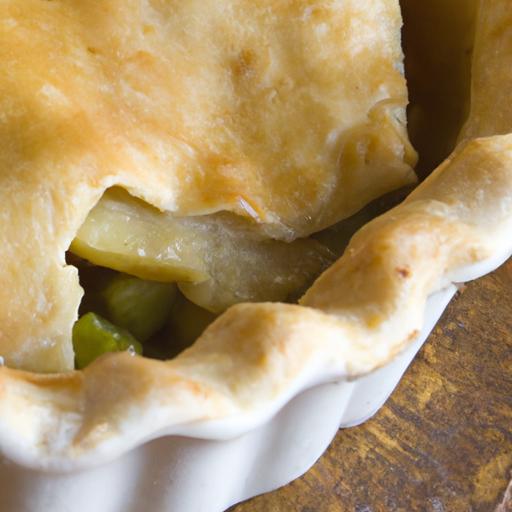There’s something undeniably comforting about a classic pot pie-the tender, savory filling nestled beneath a golden, flaky butter crust that practically melts in your mouth. This timeless dish, a staple of cozy family dinners and nostalgic home cooking, owes much of its charm to that delicate pastry shell. The flaky butter crust isn’t just a vessel for the hearty ingredients inside; it’s a work of art in its own right, balancing crisp layers with buttery richness to create the perfect contrast of textures. In this article, we’ll explore the secrets behind crafting that quintessential crust, unlocking the techniques that transform simple ingredients into a flaky, comforting masterpiece. Whether you’re a seasoned baker or a curious home cook, discover how this traditional crust elevates the humble pot pie into a dish that’s as warm and inviting as a cherished memory.
Flaky Butter Crust: Classic Comfort in a Traditional Pot Pie
The flaky butter crust is the crowning glory of any traditional pot pie, transforming a simple filling into a comforting culinary masterpiece. From the rich, buttery aroma when it bakes to the satisfying layers that melt on your tongue, crafting the perfect crust requires both quality ingredients and thoughtful technique. Inspired by cherished family recipes and years of kitchen experimentation, this guide unlocks the essence of a crust that’s irresistibly delicate yet robust enough to cradle savory fillings without sogginess.
Prep and Cook Time
- Preparation: 30 minutes
- Chilling: 1 hour (minimum, for optimal flakiness)
- Cooking: 35-40 minutes
- Total Time: Approximately 2 hours including chilling
Yield
- Serves 6 generous portions
Difficulty Level
- Medium: Requires attention to detail and some patience for chilling and handling dough.
Ingredients
- 2 ½ cups all-purpose flour, sifted
- 1 tsp fine sea salt
- 1 cup (2 sticks) unsalted butter, cold and diced – ideally European-style for higher fat content
- ½ cup ice-cold water, adjusted as needed
- 1 tbsp apple cider vinegar (optional, helps tenderize the dough)
Instructions
- Combine flour and salt. In a large mixing bowl, gently whisk together the sifted flour and sea salt until fully blended.
- Cut in the cold butter. Using a pastry cutter or your fingertips, quickly work the cold diced butter into the flour until the mixture resembles coarse pea-sized crumbs. Be careful not to overwork-small visible butter bits are key to flakiness.
- Add cold water and vinegar gradually. Drizzle the ice water and apple cider vinegar over the mixture, stirring gently with a fork or your fingers. Add enough water until the dough just comes together in clumps without being sticky.
- Form the dough and chill. Shape the dough into two discs, wrap them in plastic wrap, and refrigerate for at least 1 hour. This chilling process solidifies the butter and relaxes the gluten, crucial for a tender, flaky bite.
- Roll out the dough. On a lightly floured surface, roll one disc into a circle large enough for your pot pie dish. To create delicate layers, handle the dough gently and avoid kneading.
- Assemble the pot pie. Pour your savory filling into the dish, then carefully lay the crust on top. Trim the edges and crimp or flute to seal.
- Brush and bake. Lightly brush the crust with a beaten egg wash for a golden finish. Bake at 400°F (205°C) for 35-40 minutes until the crust is puffed, golden, and crackling with flake layers.
Chef’s Notes: Tips for Success
- Butter matters. Opt for European-style butter with at least 82% fat for an exquisitely flaky crust. The higher fat content yields a richer mouthfeel and better layers.
- Keep everything cold. From flour to butter to water, chilling all ingredients prevents premature butter melting, which compromises texture.
- Use vinegar or lemon juice. A splash of acid tenderizes gluten without compromising flavor-a subtle trick for a tender yet sturdy crust.
- Limit handling. Overworking develops gluten and results in toughness. Mix just until combined and then rest.
- Make-ahead. Dough freezes beautifully wrapped tightly in plastic wrap up to one month. Thaw overnight in the fridge before rolling.
Serving Suggestions
- Serve pot pie hot with a sprinkle of fresh chopped thyme or rosemary for an herbal lift.
- A simple side of roasted root vegetables or a crisp green salad balances richness and adds color.
- Consider topping individual servings with a dollop of creamy mashed potatoes for a layered comfort fusion.
| Nutrient | Amount per Serving |
|---|---|
| Calories | 420 kcal |
| Protein | 8 g |
| Carbohydrates | 32 g |
| Fat | 27 g |

For more on elevating classic comfort foods, explore our in-depth guide on How to Make Buttermilk Biscuits. To deepen your understanding of butter’s chemistry in baking, check out this Cook’s Illustrated article on The Science of Butter.
Q&A
Q&A: Flaky Butter Crust – Classic Comfort in a Traditional Pot Pie
Q: What makes a flaky butter crust so special for a pot pie?
A: The secret lies in the buttery layers! When you incorporate cold butter into the dough and handle it just right, it creates those tender, crisp pockets that melt in your mouth. That golden, flaky crust is the perfect cozy canopy over your savory filling, delivering both texture and rich flavor.
Q: How do you achieve that light, flaky texture instead of a tough or crumbly crust?
A: It’s all about balance and technique. Use cold butter and ice water to keep the dough cool, avoid overworking it to prevent gluten development, and handle it gently. When baked, the butter’s fat steams, creating air pockets that give you that irresistible flakiness.
Q: Can I use all butter, or should I mix fats for the crust?
A: Classic pot pies shine brightest with pure butter crusts because butter imparts unparalleled flavor and flakiness. However, some bakers blend butter with shortening or lard to achieve extra tenderness or ease of handling, but for authentic comfort, 100% butter is king.
Q: What role does the crust play beyond just taste?
A: The crust acts like a cozy blanket, keeping the pot pie’s filling steamy and flavorful. It also provides a delightful contrast in texture – crispy and flaky on the outside, soft and hearty inside. This harmony elevates the humble pot pie into a memorable comfort dish.
Q: Are there any tips for getting an even golden crust every time?
A: Absolutely! Brush the top with an egg wash-beaten egg with a splash of water or milk-to encourage even browning. Also, baking at the right temperature, usually around 375°F (190°C), ensures the crust cooks through without burning. Keep an eye on it in the final minutes for that perfect golden glow.
Q: Can a flaky butter crust be made ahead of time?
A: Yes! You can prepare and chill the dough up to two days before baking, or freeze it for longer storage. Just thaw in the fridge before rolling out. This makes it easy to whip up a soul-soothing pot pie whenever comfort calls.
Q: What fillings pair best with a flaky butter crust in a traditional pot pie?
A: Classic chicken pot pies with tender chicken, peas, carrots, and creamy sauce never go out of style, but beef, mushroom, or vegetable medleys also shine. The buttery crust complements rich, savory fillings perfectly, making every bite a nostalgic hug.
Embrace the art of a flaky butter crust and transform your pot pie into a timeless comfort food treasure. From buttery layers to warm fillings, this traditional combination is a celebration of home-cooked goodness.
To Conclude
As the warm, flaky butter crust blankets the savory filling of a traditional pot pie, it wraps every bite in a comforting embrace that transcends mere sustenance. This classic dish isn’t just a meal-it’s a nostalgic invitation to gather around the table, to savor simplicity, and to celebrate the timeless art of home cooking. Whether enjoyed on a chilly evening or as a heartfelt family favorite, the flaky butter crust remains a golden testament to culinary tradition, reminding us that sometimes, the most delicious comforts are found in the memories baked into every tender, buttery layer.

